air condition MERCEDES-BENZ SPRINTER 2015 MY15 Operator’s Manual
[x] Cancel search | Manufacturer: MERCEDES-BENZ, Model Year: 2015, Model line: SPRINTER, Model: MERCEDES-BENZ SPRINTER 2015Pages: 334, PDF Size: 5.94 MB
Page 6 of 334
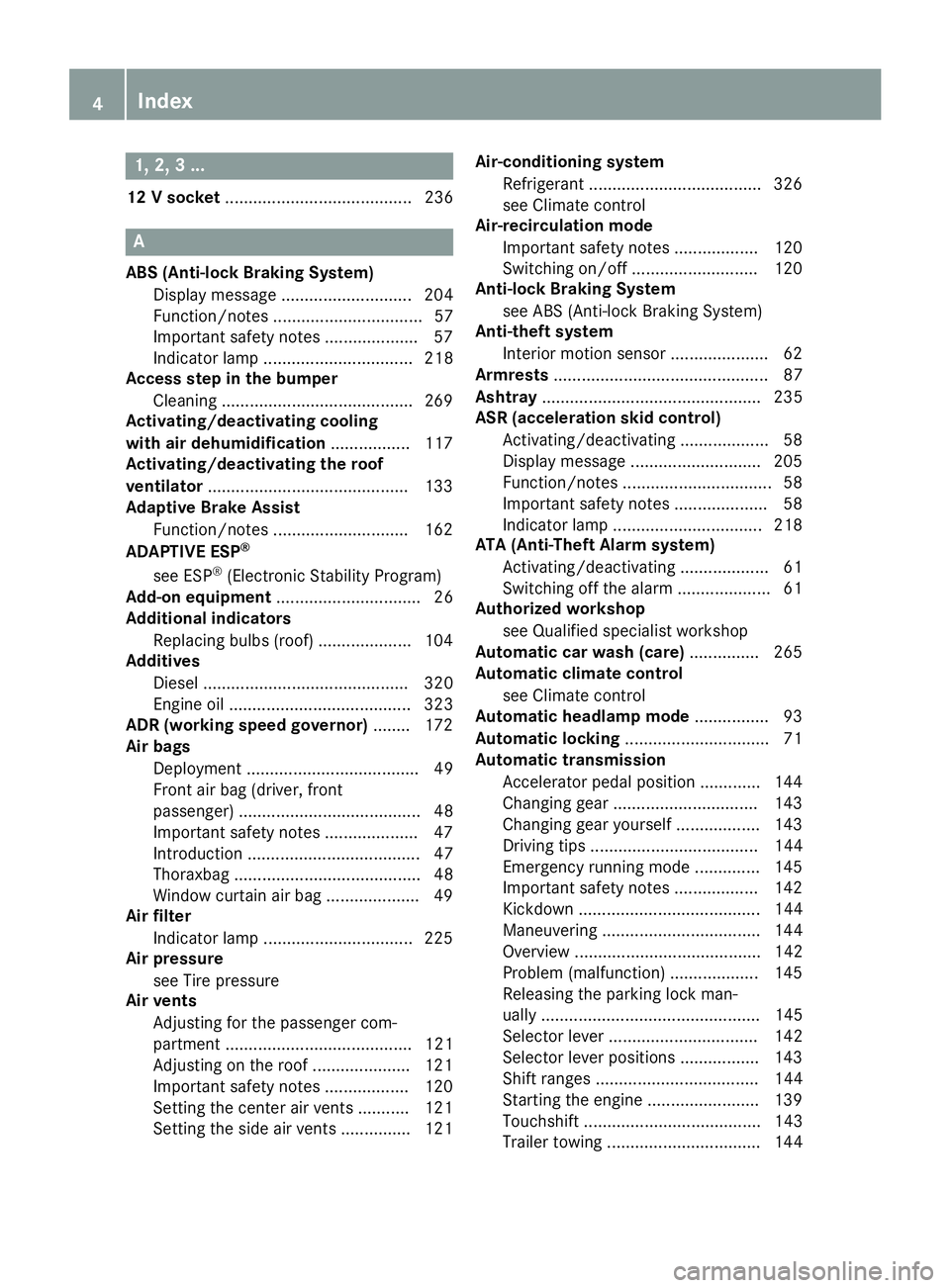
1, 2, 3 ...
12 V socket ........................................ 236 A
ABS (Anti-lock Braking System) Display message ............................ 204
Function/notes ................................ 57
Important safety notes .................... 57
Indicator lamp ................................ 218
Access step in the bumper
Cleaning .........................................2 69
Activating/deactivating cooling
with air dehumidification ................. 117
Activating/deactivating the roof
ventilator .......................................... .133
Adaptive Brake Assist
Function/notes ............................ .162
ADAPTIVE ESP ®
see ESP ®
(Electronic Stability Program)
Add-on equipment ............................... 26
Additional indicators
Replacing bulbs (roof) .................... 104
Additives
Diesel ............................................ 320
Engine oil ....................................... 323
ADR (working speed governor) ........172
Air bags
Deployment ..................................... 49
Front air bag (driver, front
passenger) ....................................... 48
Important safety notes .................... 47
Introduction ..................................... 47
Thoraxbag ........................................ 48
Window curtain air bag .................... 49
Air filter
Indicator lamp ................................ 225
Air pressure
see Tire pressure
Air vents
Adjusting for the passenger com-
partment ........................................ 121
Adjusting on the roof ..................... 121
Important safety notes .................. 120
Setting the center air vents ........... 121
Setting the side air vents .............. .121 Air-conditioning system
Refrigerant ..................................... 326
see Climate control
Air-recirculation mode
Important safety notes .................. 120
Switching on/off ........................... 120
Anti-lock Braking System
see ABS (Anti-lock Braking System)
Anti-theft system
Interior motion sensor ..................... 62
Armrests .............................................. 87
Ashtray ............................................... 235
ASR (acceleration skid control)
Activating/deactivating ................... 58
Display message ............................ 205
Function/notes ................................ 58
Important safety notes .................... 58
Indicator lamp ................................ 218
ATA (Anti-Theft Alarm system)
Activating/deactivating ................... 61
Switching off the alarm .................... 61
Authorized workshop
see Qualified specialist workshop
Automatic car wash (care) ...............265
Automatic climate control
see Climate control
Automatic headlamp mode ................ 93
Automatic locking ............................... 71
Automatic transmission
Accelerator pedal position ............. 144
Changing gear ............................... 143
Changing gear yoursel f.................. 143
Driving tips .................................... 144
Emergency running mod e.............. 145
Important safety notes .................. 142
Kickdown ....................................... 144
Maneuvering .................................. 144
Overview ........................................ 142
Problem (malfunction) ................... 145
Releasing the parking lock man-
uall y............................................... 145
Selector lever ................................ 142
Selector lever positions ................. 143
Shift ranges ................................... 144
Starting the engine ........................ 139
Touchshift ...................................... 143
Trailer towing ................................. 144 4
Index
Page 9 of 334
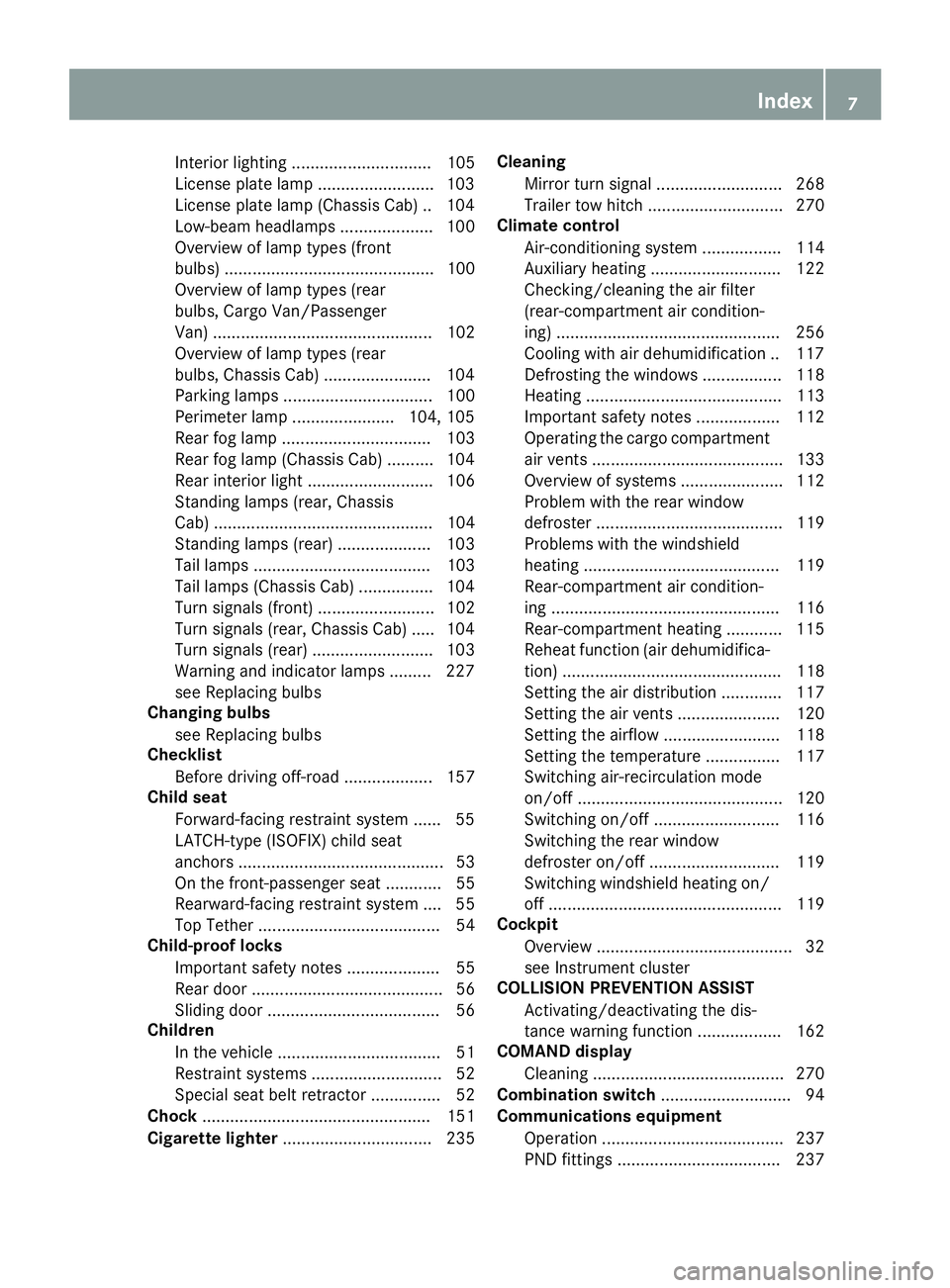
Interior lighting .............................. 105
License plate lamp .........................1
03
License plate lamp (Chassis Cab) .. 104
Low-beam headlamps .................... 100
Overview of lamp types (front
bulbs) ............................................. 100
Overview of lamp types (rear
bulbs, Cargo Van/Passenger
Van) ............................................... 102
Overview of lamp types (rear
bulbs, Chassis Cab) ....................... 104
Parking lamps ................................ 100
Perimeter lamp ..................... .104, 105
Rear fog lamp ................................ 103
Rear fog lamp (Chassis Cab) .......... 104
Rear interior light ........................... 106
Standing lamps (rear, Chassis
Cab) ............................................... 104
Standing lamps (rear) .................... 103
Tail lamps ...................................... 103
Tail lamps (Chassis Cab) ................ 104
Turn signals (front) ......................... 102
Turn signals (rear, Chassis Cab) ..... 104
Turn signals (rear) .......................... 103
Warning and indicator lamps ......... 227
see Replacing bulbs
Changing bulbs
see Replacing bulbs
Checklist
Before driving off-road ................... 157
Child seat
Forward-facing restraint system ...... 55
LATCH-type (ISOFIX) child seat
anchors ............................................ 53
On the front-passenger sea t............ 55
Rearward-facing restraint system .... 55
Top Tether ....................................... 54
Child-proof locks
Important safety notes .................... 55
Rear door ......................................... 56
Sliding door ..................................... 56
Children
In the vehicle ................................... 51
Restraint systems ............................ 52
Special seat belt retractor ............... 52
Chock ................................................. 151
Cigarette lighter ................................ 235 Cleaning
Mirror turn signal ........................... 268
Trailer tow hitch ............................. 270
Climate control
Air-conditioning system ................. 114
Auxiliary heating ............................ 122
Checking/cleaning the air filter
(rear-compartment air condition-
ing) ................................................ 256
Cooling with air dehumidification .. 117
Defrosting the windows ................. 118
Heating .......................................... 113
Important safety notes .................. 112
Operating the cargo compartment
air vents ......................................... 133
Overview of systems ...................... 112
Problem with the rear window
defroster ........................................ 119
Problems with the windshield
heating .......................................... 119
Rear-compartment air condition-
ing ................................................. 116
Rear-compartment heating ............ 115
Reheat function (air dehumidifica- tion) ............................................... 118
Setting the air distribution ............. 117
Setting the air vents ...................... 120
Setting the airflow ......................... 118
Setting the temperature ................ 117
Switching air-recirculation mode
on/of f............................................ 120
Switching on/of f........................... 116
Switching the rear window
defroster on/of f............................ 119
Switching windshield heating on/
off .................................................. 119
Cockpit
Overview .......................................... 32
see Instrument cluster
COLLISION PREVENTION ASSIST
Activating/deactivating the dis-
tance warning function .................. 162
COMAND display
Cleaning ......................................... 270
Combination switch ............................ 94
Communications equipment
Operation ....................................... 237
PND fittings ................................... 237 Index
7
Page 17 of 334

Perimeter lamp
Replacing bulbs ............................. 104
Pets in the vehicle ...............................56
Plastic trim (cleaning instruc-
tions) .................................................. 270
Power supply
Battery isolating switch ................. 137
Switching off ..................................1 37
Switching on .................................. 137
Power take-off
Engine speed setting ..................... 172
Power washers .................................. 266
Power windows
see Side windows
Preparing for a journey
Checks in the vehicle ..................... 138
Visual check of the vehicle exte-
rior ................................................. 138
Protection of the environment
General notes .................................. 23
Pulling away ...................................... 140 Q
Qualified specialist workshop ........... 25R
Radiator cover ..................................... 27
Radio
Changing stations (vehicles with
steering wheel buttons) ................. 187
see separate operating instructions
Radio-wave reception/transmis-
sion in the vehicle
Declaration of conformity ................ 24
Rain and light sensor
Setting the sensitivity (vehicles
with steering wheel buttons) ......... 193
Windshield wiper ........................... 107
Range (vehicles with steering
wheel buttons) .................................. 195
Rear bench seat
Installing/removing (Passenger
Van) ................................................. 85
Stowage compartment (crewcab) .. 233 Rear compartment
Activating/deactivating climate
control .......................................... .116
Setting the air vents ..................... .121
Rear door
Child-proof locks .............................. 56
Important safety notes .................... 75
Opening/closing .............................. 75
Rear fog lamp
Replacing bulbs ............................ .103
Switching on/off .............................. 93
Rear fog lamp (Chassis Cab)
Replacing bulbs ............................ .104
Rear interior light
Replacing bulbs ............................ .106
Rear lamps
see Lights
Rear rack
Notes ............................................. 245
Rear view camera
Cleaning instructions ..................... 269
Important safety notes .................. 171
Switching on .................................. 171
Rear window defroster
Problem (malfunction) ................... 119
Switching on/off ........................... 119
Rear window wiper ........................... 108
Switching on/off ........................... 108
Rear-compartment air-condition-
ing system
see Climate control
Rear-compartment heating
see Climate control
Rear-view mirror
Anti-glare mode ............................... 89
Refilling
DEF filler neck ............................... 148
Important safety notes (Diesel
Exhaust Fluid – DEF) ..................... .147
Refilling procedure (Diesel
Exhaust Fluid – DEF) ..................... .148
Refrigerant ......................................... 326
Refueling
Fuel filler fla p................................. 146
Fuel gauge ..................................... 181
Important safety notes (fuel )......... 145
Refueling procedure (fuel )............. 146
see Fuel Index
15
Page 26 of 334
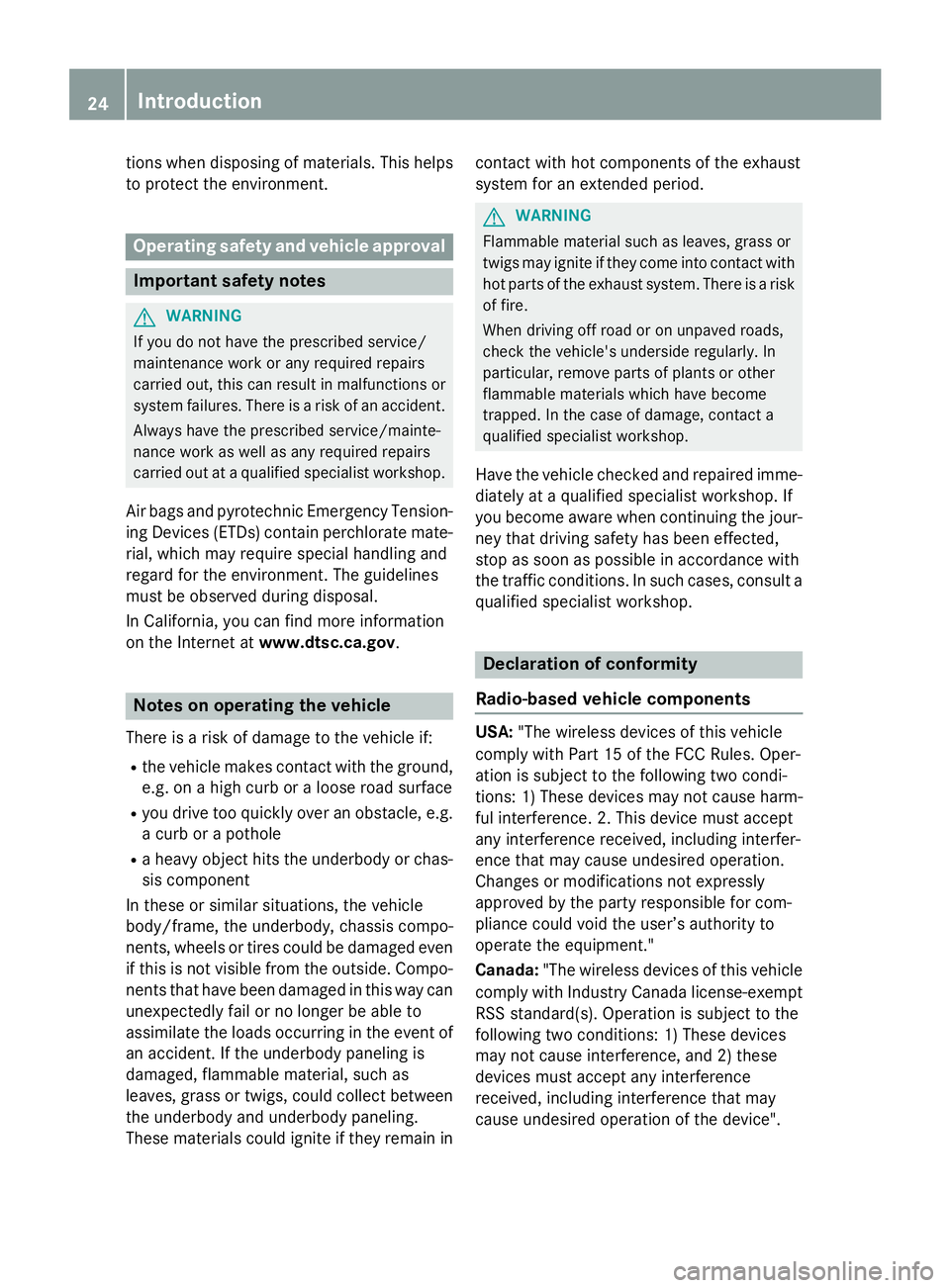
tions when disposing of materials. This helps
to protect the environment. Operating safety and vehicle approval
Important safety notes
G
WARNING
If you do not have the prescribed service/
maintenance work or any required repairs
carried out, this can result in malfunctions or system failures. There is a risk of an accident.
Always have the prescribed service/mainte-
nance work as well as any required repairs
carried out at a qualified specialist workshop.
Air bags and pyrotechnic Emergency Tension-
ing Devices (ETDs) contain perchlorate mate-
rial, which may require special handling and
regard for the environment. The guidelines
must be observed during disposal.
In California, you can find more information
on the Internet at www.dtsc.ca.gov. Notes on operating the vehicle
There is a risk of damage to the vehicle if:
R the vehicle makes contact with the ground,
e.g. on a high curb or a loose road surface
R you drive too quickly over an obstacle, e.g.
a curb or a pothole
R a heavy object hits the underbody or chas-
sis component
In these or similar situations, the vehicle
body/frame, the underbody, chassis compo-
nents, wheels or tires could be damaged even
if this is not visible from the outside. Compo-
nents that have been damaged in this way can
unexpectedly fail or no longer be able to
assimilate the loads occurring in the event of an accident. If the underbody paneling is
damaged, flammable material, such as
leaves, grass or twigs, could collect between the underbody and underbody paneling.
These materials could ignite if they remain in contact with hot components of the exhaust
system for an extended period. G
WARNING
Flammable material such as leaves, grass or
twigs may ignite if they come into contact with hot parts of the exhaust system. There is a risk of fire.
When driving off road or on unpaved roads,
check the vehicle's underside regularly. In
particular, remove parts of plants or other
flammable materials which have become
trapped. In the case of damage, contact a
qualified specialist workshop.
Have the vehicle checked and repaired imme- diately at a qualified specialist workshop. If
you become aware when continuing the jour-
ney that driving safety has been effected,
stop as soon as possible in accordance with
the traffic conditions. In such cases, consult a
qualified specialist workshop. Declaration of conformity
Radio-based vehicle components USA:
"The wireless devices of this vehicle
comply with Part 15 of the FCC Rules. Oper-
ation is subject to the following two condi-
tions: 1) These devices may not cause harm-
ful interference. 2. This device must accept
any interference received, including interfer-
ence that may cause undesired operation.
Changes or modifications not expressly
approved by the party responsible for com-
pliance could void the user’s authority to
operate the equipment."
Canada: "The wireless devices of this vehicle
comply with Industry Canada license-exempt RSS standard(s). Operation is subject to the
following two conditions: 1) These devices
may not cause interference, and 2) these
devices must accept any interference
received, including interference that may
cause undesired operation of the device". 24
Introduction
Page 28 of 334
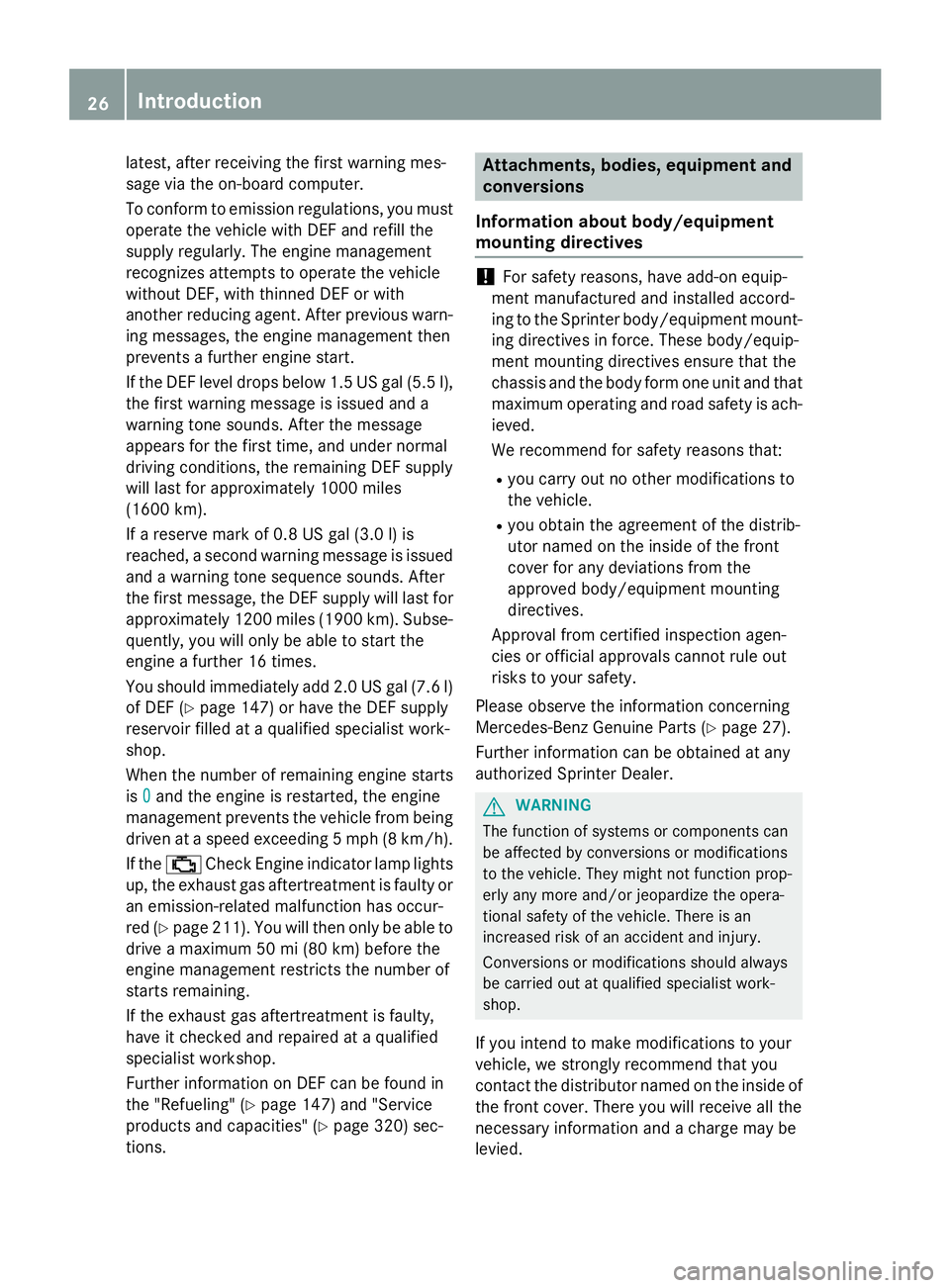
latest, after receiving the first warning mes-
sage via the on-board computer.
To conform to emission regulations, you must
operate the vehicle with DEF and refill the
supply regularly. The engine management
recognizes attempts to operate the vehicle
without DEF, with thinned DEF or with
another reducing agent. After previous warn-
ing messages, the engine management then
prevents a further engine start.
If the DEF level drops below 1.5 US gal (5.5 l), the first warning message is issued and a
warning tone sounds. After the message
appears for the first time, and under normal
driving conditions, the remaining DEF supply
will last for approximately 1000 miles
(1600 km).
If a reserve mark of 0.8 US gal (3.0 l) is
reached, a second warning message is issued and a warning tone sequence sounds. After
the first message, the DEF supply will last for
approximately 1200 miles (1900 km). Subse-
quently, you will only be able to start the
engine a further 16 times.
You should immediately add 2.0 US gal (7.6 l)
of DEF (Y page 147) or have the DEF supply
reservoir filled at a qualified specialist work-
shop.
When the number of remaining engine starts
is 0
0 and the engine is restarted, the engine
management prevents the vehicle from being
driven at a speed exceeding 5 mph (8 km/h).
If the 00B9 Check Engine indicator lamp lights
up, the exhaust gas aftertreatment is faulty or
an emission-related malfunction has occur-
red (Y page 211). You will then only be able to
drive a maximum 50 mi (80 km) before the
engine management restricts the number of
starts remaining.
If the exhaust gas aftertreatment is faulty,
have it checked and repaired at a qualified
specialist workshop.
Further information on DEF can be found in
the "Refueling" (Y page 147) and "Service
products and capacities" (Y page 320) sec-
tions. Attachments, bodies, equipment and
conversions
Information about body/equipment
mounting directives !
For safety reasons, have add-on equip-
ment manufactured and installed accord-
ing to the Sprinter body/equipment mount- ing directives in force. These body/equip-
ment mounting directives ensure that the
chassis and the body form one unit and that
maximum operating and road safety is ach- ieved.
We recommend for safety reasons that:
R you carry out no other modifications to
the vehicle.
R you obtain the agreement of the distrib-
utor named on the inside of the front
cover for any deviations from the
approved body/equipment mounting
directives.
Approval from certified inspection agen-
cies or official approvals cannot rule out
risks to your safety.
Please observe the information concerning
Mercedes-Benz Genuine Parts (Y page 27).
Further information can be obtained at any
authorized Sprinter Dealer. G
WARNING
The function of systems or components can
be affected by conversions or modifications
to the vehicle. They might not function prop-
erly any more and/or jeopardize the opera-
tional safety of the vehicle. There is an
increased risk of an accident and injury.
Conversions or modifications should always
be carried out at qualified specialist work-
shop.
If you intend to make modifications to your
vehicle, we strongly recommend that you
contact the distributor named on the inside of
the front cover. There you will receive all the
necessary information and a charge may be
levied. 26
Introduction
Page 29 of 334
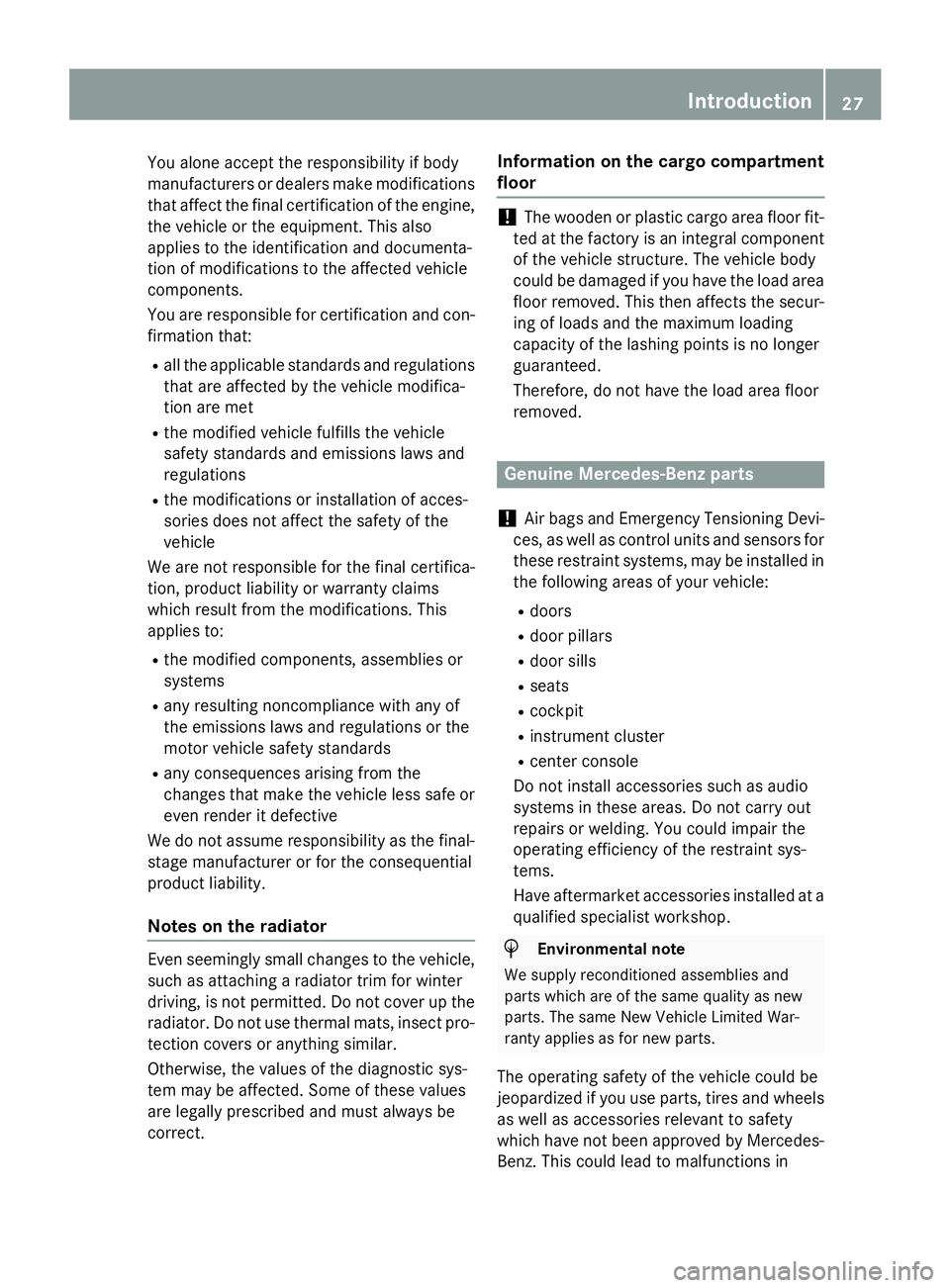
You alone accept the responsibility if body
manufacturers or dealers make modifications that affect the final certification of the engine,
the vehicle or the equipment. This also
applies to the identification and documenta-
tion of modifications to the affected vehicle
components.
You are responsible for certification and con- firmation that:
R all the applicable standards and regulations
that are affected by the vehicle modifica-
tion are met
R the modified vehicle fulfills the vehicle
safety standards and emissions laws and
regulations
R the modifications or installation of acces-
sories does not affect the safety of the
vehicle
We are not responsible for the final certifica-
tion, product liability or warranty claims
which result from the modifications. This
applies to:
R the modified components, assemblies or
systems
R any resulting noncompliance with any of
the emissions laws and regulations or the
motor vehicle safety standards
R any consequences arising from the
changes that make the vehicle less safe or even render it defective
We do not assume responsibility as the final- stage manufacturer or for the consequential
product liability.
Notes on the radiator Even seemingly small changes to the vehicle,
such as attaching a radiator trim for winter
driving, is not permitted. Do not cover up the radiator. Do not use thermal mats, insect pro-
tection covers or anything similar.
Otherwise, the values of the diagnostic sys-
tem may be affected. Some of these values
are legally prescribed and must always be
correct. Information on the cargo compartment
floor !
The wooden or plastic cargo area floor fit-
ted at the factory is an integral component
of the vehicle structure. The vehicle body
could be damaged if you have the load area floor removed. This then affects the secur-ing of loads and the maximum loading
capacity of the lashing points is no longer
guaranteed.
Therefore, do not have the load area floor
removed. Genuine Mercedes-Benz parts
! Air bags and Emergency Tensioning Devi-
ces, as well as control units and sensors for
these restraint systems, may be installed in the following areas of your vehicle:
R doors
R door pillars
R door sills
R seats
R cockpit
R instrument cluster
R center console
Do not install accessories such as audio
systems in these areas. Do not carry out
repairs or welding. You could impair the
operating efficiency of the restraint sys-
tems.
Have aftermarket accessories installed at a
qualified specialist workshop. H
Environmental note
We supply reconditioned assemblies and
parts which are of the same quality as new
parts. The same New Vehicle Limited War-
ranty applies as for new parts.
The operating safety of the vehicle could be
jeopardized if you use parts, tires and wheels
as well as accessories relevant to safety
which have not been approved by Mercedes-
Benz. This could lead to malfunctions in Introduction
27 Z
Page 31 of 334
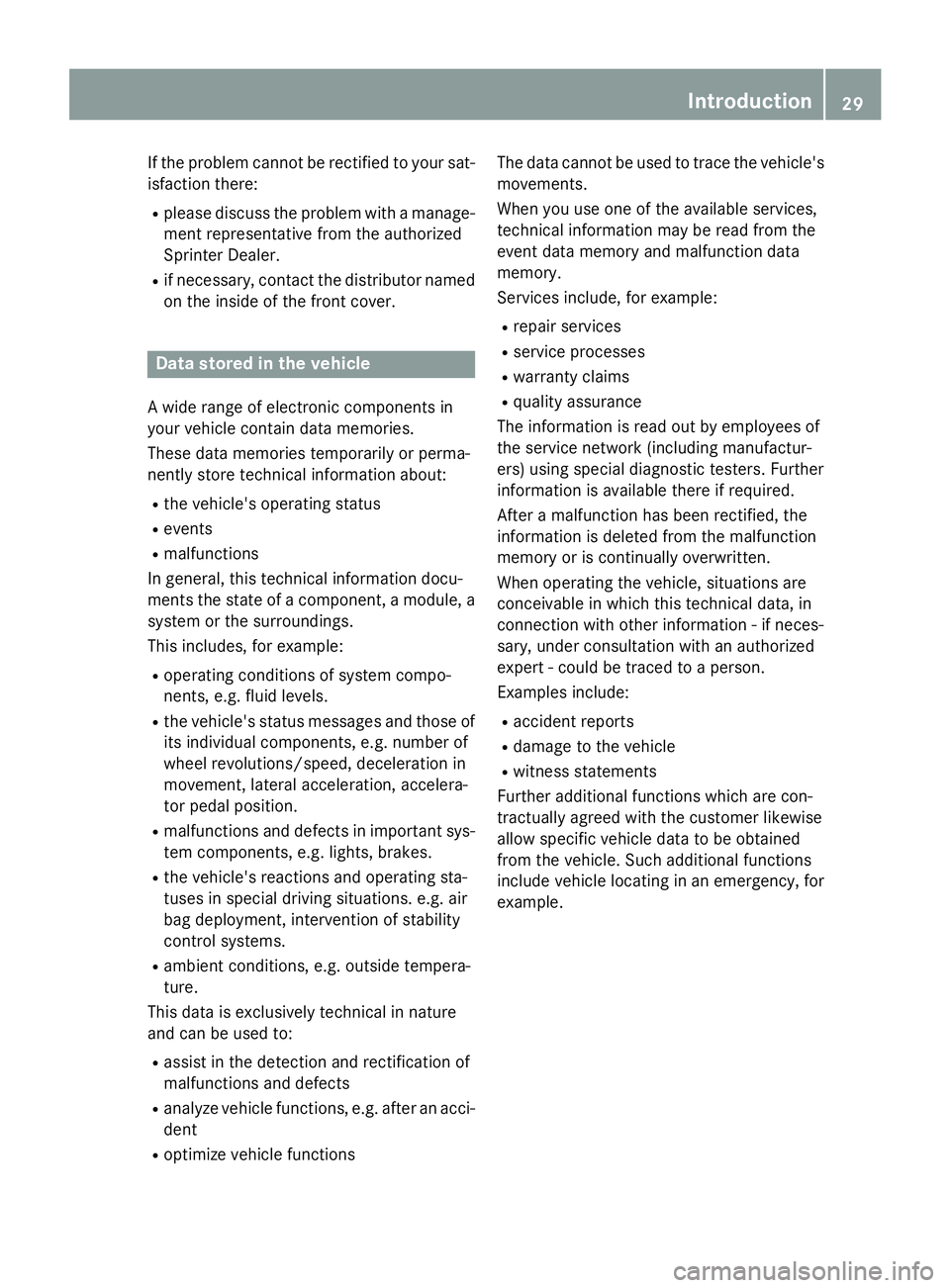
If the problem cannot be rectified to your sat-
isfaction there:
R please discuss the problem with a manage-
ment representative from the authorized
Sprinter Dealer.
R if necessary, contact the distributor named
on the inside of the front cover. Data stored in the vehicle
A wide range of electronic components in
your vehicle contain data memories.
These data memories temporarily or perma-
nently store technical information about:
R the vehicle's operating status
R events
R malfunctions
In general, this technical information docu-
ments the state of a component, a module, a
system or the surroundings.
This includes, for example:
R operating conditions of system compo-
nents, e.g. fluid levels.
R the vehicle's status messages and those of
its individual components, e.g. number of
wheel revolutions/speed, deceleration in
movement, lateral acceleration, accelera-
tor pedal position.
R malfunctions and defects in important sys-
tem components, e.g. lights, brakes.
R the vehicle's reactions and operating sta-
tuses in special driving situations. e.g. air
bag deployment, intervention of stability
control systems.
R ambient conditions, e.g. outside tempera-
ture.
This data is exclusively technical in nature
and can be used to:
R assist in the detection and rectification of
malfunctions and defects
R analyze vehicle functions, e.g. after an acci-
dent
R optimize vehicle functions The data cannot be used to trace the vehicle's
movements.
When you use one of the available services,
technical information may be read from the
event data memory and malfunction data
memory.
Services include, for example:
R repair services
R service processes
R warranty claims
R quality assurance
The information is read out by employees of
the service network (including manufactur-
ers) using special diagnostic testers. Further
information is available there if required.
After a malfunction has been rectified, the
information is deleted from the malfunction
memory or is continually overwritten.
When operating the vehicle, situations are
conceivable in which this technical data, in
connection with other information - if neces-
sary, under consultation with an authorized
expert - could be traced to a person.
Examples include:
R accident reports
R damage to the vehicle
R witness statements
Further additional functions which are con-
tractually agreed with the customer likewise
allow specific vehicle data to be obtained
from the vehicle. Such additional functions
include vehicle locating in an emergency, for
example. Introduction
29 Z
Page 39 of 334

Steering wheel buttons
Function Page
0043
Display 184
On-board computer oper-
ation 0044
Selects a submenu or
adjusts the volume
184
0081
Up/increases the vol-
ume 0082
Down/reduces the
volume Using the telephone 196
0061
Accepts a call/starts
dialing 0076
Ends a call/rejects an
incoming call 0087
Scrolls from one menu to
another
184
0080
Forwards 007F
Back Scrolls within a menu 184
0063
Forwards 0064
Back Center console
Function Page
0043
Stowage compartment 231
0044
Audio 10 or Audio 15 (see
the separate operating
instructions)
0087
Air-conditioning control
panel
112
Paper holder
1 233
0085 Center console control
panel
0072
Switches the left/right-
hand seat heating on/off
87
0085
Switches the windshield
heating on/off
119
0071
Switches the rear window
defroster on/off
119
0069
Activates/deactivates
PARKTRONIC
169
1
Only on vehicles without rear-compartment climate control. Center console
37At a glance
Page 59 of 334

As a result, they could:
R activate vehicle equipment and become
trapped, for example
R activate or deactivate systems, thereby
endangering other road users
Unsecured animals could also be flung around the vehicle in the event of an accident or sud-
den steering or braking, thereby injuring vehi- cle occupants. There is a risk of an accident
and injury.
Never leave animals unattended in the vehi-
cle. Always secure animals properly during
the journey, e.g. use a suitable animal trans-
port box. Driving safety systems
Overview
In this section, you will find information about the following driving safety systems:
R ABS ( Anti-lock BrakingSystem)
R ASR (A cceleration SkidControl)
R BAS (B rakeAssist System)
R EBD ( Electronic Brake Force Distribution)
R ESP ®
(E lectronic StabilityProgram) Important safety notes
If you fail to adapt your driving style or if you
are inattentive, the driving safety systems can
neither reduce the risk of accident nor over-
ride the laws of physics. Driving safety sys-
tems are merely aids designed to assist driv- ing. You are responsible for the distance to
the vehicle in front, for vehicle speed, braking in good time and for staying in your lane.
Always adapt your driving style to the prevail-
ing road and weather conditions and maintain a sufficient, safe distance from other road
users. Drive carefully.
The driving safety systems described can only
attain their maximum effectiveness when
there is optimum contact between the tires and the road can. Pay particular attention to
the information regarding tires, recommen-
ded minimum tire tread depth etc. under
"Wheels and tires" (Y page 284).
In wintry driving conditions, always use winter
tires (M+S tires) and if necessary, snow
chains. This is the only way to get the full
benefit from the driving safety systems
described. ABS (Anti-lock Braking System)
Important safety notes Observe the important safety guidelines for
the driving safety system (Y
page 57). G
WARNING
If ABS is faulty, the wheels could lock when
braking. The steerability and braking charac-
teristics may be severely impaired. Addition-
ally, further driving safety systems are deac-
tivated. There is an increased danger of skid- ding and accidents.
Drive on carefully. Have ABS checked imme-
diately at a qualified specialist workshop.
If ABS is malfunctioning, other systems will
also fail, including driving safety systems.
Observe the information relating to the 0025
warning lamp (Y page 218).
ABS regulates brake pressure in such a way
that the wheels do not lock when you brake.
This allows you to continue steering the vehi-
cle when braking.
ABS works from a speed of about 5 mph
(8 km/h), regardless of road-surface condi-
tions. ABS works on slippery surfaces, even
when you only brake gently.
The yellow 0025warning lamp in the instru-
ment cluster lights up when the ignition is
switched on. The lamp goes out when the
engine starts running. Driving safety systems
57Safety Z
Page 62 of 334
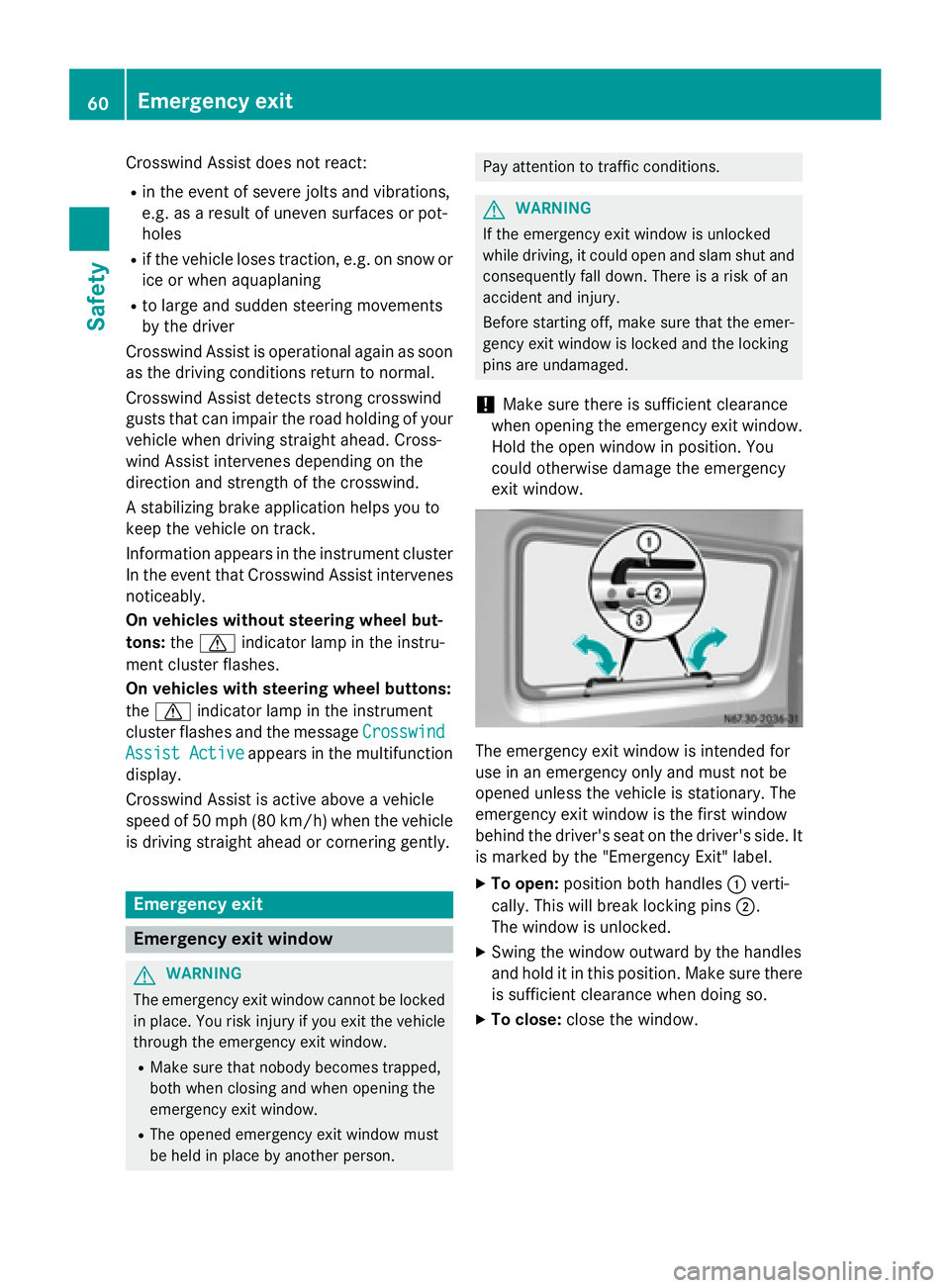
Crosswind Assist does not react:
R in the event of severe jolts and vibrations,
e.g. as a result of uneven surfaces or pot-
holes
R if the vehicle loses traction, e.g. on snow or
ice or when aquaplaning
R to large and sudden steering movements
by the driver
Crosswind Assist is operational again as soon as the driving conditions return to normal.
Crosswind Assist detects strong crosswind
gusts that can impair the road holding of your
vehicle when driving straight ahead. Cross-
wind Assist intervenes depending on the
direction and strength of the crosswind.
A stabilizing brake application helps you to
keep the vehicle on track.
Information appears in the instrument cluster
In the event that Crosswind Assist intervenes noticeably.
On vehicles without steering wheel but-
tons: the0072 indicator lamp in the instru-
ment cluster flashes.
On vehicles with steering wheel buttons:
the 0072 indicator lamp in the instrument
cluster flashes and the message Crosswind
Crosswind
Assist Active Assist Active appears in the multifunction
display.
Crosswind Assist is active above a vehicle
speed of 50 mph (80 km/h)when the vehicle
is driving straight ahead or cornering gently. Emergency exit
Emergency exit window
G
WARNING
The emergency exit window cannot be locked in place. You risk injury if you exit the vehicle
through the emergency exit window.
R Make sure that nobody becomes trapped,
both when closing and when opening the
emergency exit window.
R The opened emergency exit window must
be held in place by another person. Pay attention to traffic conditions.
G
WARNING
If the emergency exit window is unlocked
while driving, it could open and slam shut and consequently fall down. There is a risk of an
accident and injury.
Before starting off, make sure that the emer-
gency exit window is locked and the locking
pins are undamaged.
! Make sure there is sufficient clearance
when opening the emergency exit window. Hold the open window in position. You
could otherwise damage the emergency
exit window. The emergency exit window is intended for
use in an emergency only and must not be
opened unless the vehicle is stationary. The
emergency exit window is the first window
behind the driver's seat on the driver's side. It
is marked by the "Emergency Exit" label.
X To open: position both handles 0043verti-
cally. This will break locking pins 0044.
The window is unlocked.
X Swing the window outward by the handles
and hold it in this position. Make sure there
is sufficient clearance when doing so.
X To close: close the window. 60
Emergency exitSafety